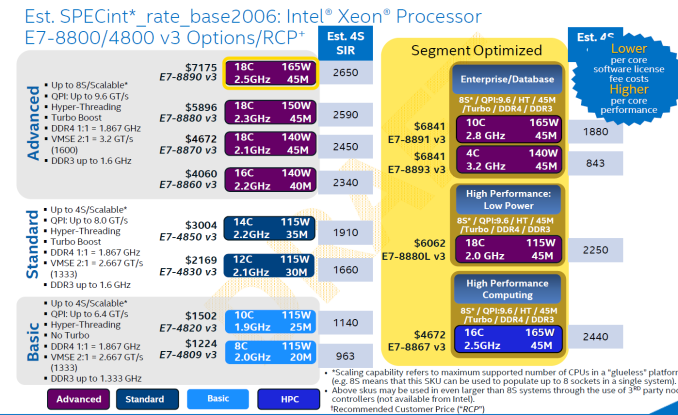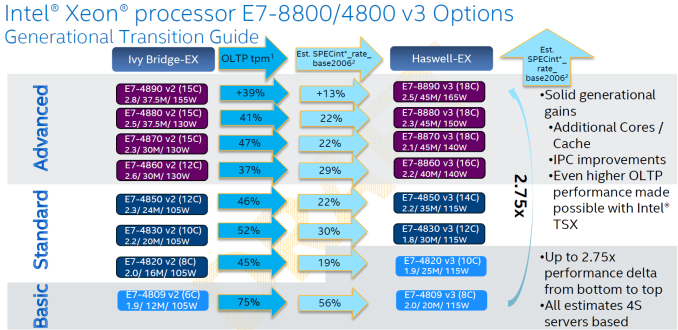The Intel Xeon E7-8800 v3 Review: The POWER8 Killer?
by Johan De Gelas on May 8, 2015 8:00 AM EST- Posted in
- CPUs
- IT Computing
- Intel
- Xeon
- Haswell
- Enterprise
- server
- Enterprise CPUs
- POWER
- POWER8
Xeon E7 v3 SKUs and prices
Intel SKU list has always been complex and very long. For reference, this is what the Xeon E7 v2 line-up looked like when it launched in 2014:
There is a scalable 2S line that is not scalable beyond 2 sockets, a frequency optimized 8857 which is probably faster in many applications than the 8893 and so on.
Luckily, with the introduction of the Xeon E7 v3, Intel simplified the SKU list.
First of all, the hardly scalable 2 socket version is gone. And at the low-end, you now get a 8-core processor at 2 GHz instead of a 6-core at 1.9 GHz. Well done, Intel.
The high-end models are all capable of running in 8 socket configurations. But the enterprise people looking for a high-end quad socket system have to pay a bit more: about 8 to 10%. Most enterprise people will not care, but getting 20% more cores (slightly improved) at 8-10% lower clocks while paying about 8% more is not exactly a vast improvement. Of course these are paper specs, but Intel used to be (a lot) more generous.
Intel's own slides confirm this. The gains in SPECint2006_rate are pretty small to justify the price increase. Intel claims higher OLTP (TPC-C) increases, but the mentioned gains are rather optimistic. For example, the HammerDB benchmark runs 29% faster on the E7-8890 v3 than on the E7-4890v2. This benchmark is much more transparant, straight forward and easier to reproduce than TPC-C, so we feel it is probably closer to the real world. Secondly, in both cases (HammerDB and TPC-C), the E7-8890v3 had twice as much memory (1 TB vs 512 GB) memory as its predecessor.
Lastly, these are benchmarks after all. In the real world systems are not running at full speed, so the gains are much smaller. So it seems that in most applications besides the TSX/AVX2 enabled ones, the gains will be rather small.













146 Comments
View All Comments
TheSocket - Friday, May 8, 2015 - link
They sure wouldn't lose the x86-64 license since they own it and Intel is licensing it from AMD.melgross - Saturday, May 9, 2015 - link
But without the license from Intel, it is worthless. There's also the question of how that works. I believe that Intel doesn't need to license back the 64 bit extensions.Kevin G - Monday, May 11, 2015 - link
This one of the reasons why it would be in Intelsat best interest to let AMD be bought out with the 32 bit license intact. The 64 bit license/patents going to a third party that doesn't want to share would be a dooms day scenario for Intel. Legally it wouldn't affect anything currently on the market but it'd throw Intel's future roadmap into the trash.Death666Angel - Saturday, May 9, 2015 - link
Pretty sure some regulatory bodies would step in if Intel were the only x86 game in town. And x86-64 is AMD property.JumpingJack - Saturday, May 9, 2015 - link
Any patents on x86 are long expired, AMD only owns the IP related to the extension of the x86 not the instruction set.patrickjp93 - Monday, May 11, 2015 - link
Not true. The U.S. government has them locked up under special military-based protections. Absolutely no one can make and sell x86 without Intel's and the DOD's permission.Kevin G - Monday, May 11, 2015 - link
Got a source for that?I know that DoD did some validation on x86 many years ago. (The Pentium core used by Larrabee had the DoD changes incorporated.)
haplo602 - Friday, May 8, 2015 - link
hmm ... where's the RAS feature comparison/test ? did I miss it in the article ?TeXWiller - Friday, May 8, 2015 - link
In the E7v3 vs POWER comparison table, there should be 32 PCIe lanes instead 40 in the Xeon column.TeXWiller - Friday, May 8, 2015 - link
Additionally, it is the L3 in POWER8 that runs half of the core speed. L2 runs at the core speed.